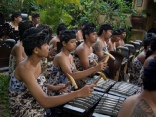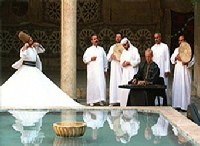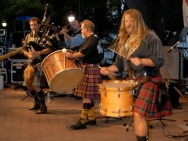










Bali The music from the Indonesian island, Bali, is mentioned because of its unique qualities. It is created to entertain the gods and deify ancestors at various ceremonies. Ensemble based, it is performed by orchestras called gamelans. The music is full of insistent rhythms and elegant patterns. There is hardly any improvisation. Using mainly percussion instruments, metallophones, xylophones, drums, cymbals, pots, with a few melodic strings and flutes, the music is otherworldly. Based on a 5 note pentatonic scale, the music uses single pitched instruments, by design. Instruments of close pitch are grouped and, when hit simultaneously, produce a third phantom note that beats and propels the music. Performances by groups of up to 35 are extended and lively, punctuated with accents and pulses. It is useful as a sound tool because of the rhythms and variances, the collectively pitches, and the energy and intention of the performances. The healer can use it to stir remnant and resistant vibrations in the belly and throat. Unique also to the Balinese culture is the kecak, a vocal chant that mimics the sound of monkeys. Listen as we explore the gamelan orchestra and the monkey chant.
The music from the Indonesian island, Bali, is mentioned because of its unique qualities. It is created to entertain the gods and deify ancestors at various ceremonies. Ensemble based, it is performed by orchestras called gamelans. The music is full of insistent rhythms and elegant patterns. There is hardly any improvisation. Using mainly percussion instruments, metallophones, xylophones, drums, cymbals, pots, with a few melodic strings and flutes, the music is otherworldly. Based on a 5 note pentatonic scale, the music uses single pitched instruments, by design. Instruments of close pitch are grouped and, when hit simultaneously, produce a third phantom note that beats and propels the music. Performances by groups of up to 35 are extended and lively, punctuated with accents and pulses. It is useful as a sound tool because of the rhythms and variances, the collectively pitches, and the energy and intention of the performances. The healer can use it to stir remnant and resistant vibrations in the belly and throat. Unique also to the Balinese culture is the kecak, a vocal chant that mimics the sound of monkeys. Listen as we explore the gamelan orchestra and the monkey chant.
Middle East The unique music of Western Asia and northern Africa is instantly recognizable from its unique vocalization scales, driving rhythms, drums and plucked instruments. The 17, 19, or 24 notes to an octave creates room for notes between notes to the Western ear. This creates unique scales and causes the singers to rise and fall in flourishes as they access the quarter tones. Punctuated with hip driving rhythms the music is infectious, sensuous, and spiritually expansive. 32 different rhythms for doumbek, frame drum, and tambourine create a useful array of sound to allow the sound healer to support grounding, emotional release, and taking action. The oud, the double reed horns, and ney flute create a haunting tonal quality that blends well with the often nasal focused voice of the singer. The music of the Middle East has a strong Islamic spiritual undertone. It addresses love and homeland as common themes.
The unique music of Western Asia and northern Africa is instantly recognizable from its unique vocalization scales, driving rhythms, drums and plucked instruments. The 17, 19, or 24 notes to an octave creates room for notes between notes to the Western ear. This creates unique scales and causes the singers to rise and fall in flourishes as they access the quarter tones. Punctuated with hip driving rhythms the music is infectious, sensuous, and spiritually expansive. 32 different rhythms for doumbek, frame drum, and tambourine create a useful array of sound to allow the sound healer to support grounding, emotional release, and taking action. The oud, the double reed horns, and ney flute create a haunting tonal quality that blends well with the often nasal focused voice of the singer. The music of the Middle East has a strong Islamic spiritual undertone. It addresses love and homeland as common themes.
Israel
In Jewish tradition, music was viewed as a necessity in everyday life, as a beautifying and enriching complement of human existence. The music was both religious and secular. Originally, the music was temple or synagogue based, using direct passages of the torah as lyric to teach or as prayers. To this day, the music carries the original flavor in the Orthodox circles, sung and spoken in a unique, somewhat nasal tonality. Of particular interest to the sound healer is the style, Baqashot , which reflects elements of the mystical practice of the Kabballah. The styles of Jewish music range from the spoken chant to the cantor singing over the congregation, from the sung instrumental practice of Nigun to the group celebrations and dances. Mostly, the feel of the classic Jewish song brings joy and celebration to the forefront in a dance style that starts slowly and builds to a frenzied climax. As it is both a reflection of the Divine and a celebration of life on Earth, Jewish music is a useful tool to influence the clients spirit and mood. Of particular interest are the rhythms and melodies of the typically Yiddish, Klezmer music.
mystical practice of the Kabballah. The styles of Jewish music range from the spoken chant to the cantor singing over the congregation, from the sung instrumental practice of Nigun to the group celebrations and dances. Mostly, the feel of the classic Jewish song brings joy and celebration to the forefront in a dance style that starts slowly and builds to a frenzied climax. As it is both a reflection of the Divine and a celebration of life on Earth, Jewish music is a useful tool to influence the clients spirit and mood. Of particular interest are the rhythms and melodies of the typically Yiddish, Klezmer music.
Celtic
Music from Ireland, Scotland, Wales, and England has evolved into a modern musical classification called Celtic Music. It is not simply the music of the Celts, for little has really survived that reflects that. It is more a sound that is at once heartfelt, upbeat, reflective, yearning, spiritual, and ancient. Based upon pentatonic and minor scales much of this music has swept through the current times to populate New Age catalogs. Utilizing penny whistles, bodhran drums, Uilleann Pipes, bagpipes, guitar, harp, and synthesizer the Celtic music is a harkening back to a deeper inner space. For the Sound Healer, the music is ideal for clearing heart chakras, for inspiring vision, for initiating the spirit of the journey, for returning to a child-
music is a harkening back to a deeper inner space. For the Sound Healer, the music is ideal for clearing heart chakras, for inspiring vision, for initiating the spirit of the journey, for returning to a child-
Page 9
Click to access Sound Healing History, part 4 page 3

LEARNING BLOCKS Sound and Vibration l Voice l Chakras l Energy l Singing l Sound Healing Tools l Color l Senses
Music Therapy l Resources l Sound Healing Sessions l Applications

Sound Healing History l Contemporary Sound Healers l Physics of Sound l Esoterics of Sound l Cymatics l Sacred Geometry l Vibration l
Frequency and Pitch l Intervals l Scales and Keys l Hearing and Listening



